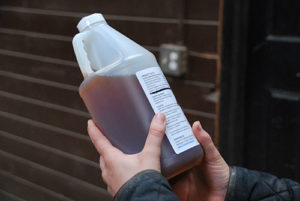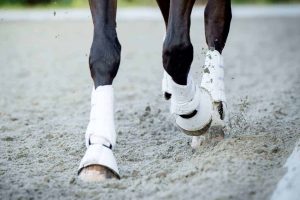Regenerative Therapies for Managing Equine Osteoarthritis

Biologic, or regenerative, therapies have altered the way many equine veterinarians treat problematic joints. Some of the most mainstream and popular modalities they currently use to manage osteoarthritis (OA) in horses are autologous conditioned serum, autologous protein solution, platelet-rich plasma, and mesenchymal stem cells.
Most biologic therapies involve collecting and concentrating the horse’s natural anti-inflammatory and regenerative proteins or cells so they can be injected into an area of pathology (disease or damage) in the same horse.
Autologous Conditioned Serum (ACS)
Autologous conditioned serum is a cell-free extract of whole blood that has been processed to contain high concentrations of interleukin-1 receptor antagonist protein (IRAP), a naturally occurring anti-inflammatory protein within the body. It is marketed under the trade names IRAP and IRAP II.
When preparing ACS, veterinarians collect venous blood in a proprietary syringe system that encourages porous glass beads to bind with white blood cells. During an incubation process the bound white cells release high concentrations of IRAP. The veterinarian then draws the serum off into small portions and freezes it for future injection into arthritic joints. In clinical studies of ACS, researchers have reported improved synovial membrane (joint surface lining) health, stimulation of natural IRAP production, and improved lameness.
Platelet-Rich Plasma (PRP)
Platelet rich plasma is blood plasma that’s been centrifuged or filtrated to have a higher concentration of platelets than whole blood. Many horse owners are familiar with PRP and its use in tendon and ligament injuries; however, veterinarians are using it more regularly for treating joint disease.
One of platelets’ roles in the body is to modulate tissue healing. They do so by releasing growth factors and signaling molecules that initiate repair and promote anabolic (supporting tissue growth) effects. Veterinarians have capitalized on this ability by injecting high concentrations of platelets directly into damaged or inflamed regions. Because many PRP systems allow for stallside preparation, it is a convenient option for immediate treatment without the hassle of incubation or culturing in the lab, as is the case with ACS and stem cell preparation, respectively.
Historically, equine veterinarians have primarily used PRP to help treat soft tissue injuries. More recent work has led to intra-articular (in the joint) use with promising results. Although researchers have demonstrated how platelet-derived products work in vitro (in the lab) and veterinarians have seen promising anecdotal results in vivo (in the live horse), they’ve yet to produce evidence-based confirmation of its clinical efficacy.
Mark Revenaugh, DVM, owner of Northwest Equine Performance, in Mulino, Oregon, says the main factors standing between researchers’ ability to gather objective data and establish a consensus on PRP’s efficacy are the high variability among preparation systems, individual patient reactivity to the product, and an unknown ideal concentration of platelets for particular injuries.
“Most practitioners can’t always check how many platelets are being used,” he says. “Depending on the system, one veterinarian may be using 100,000 platelets/milliliter and another veterinarian may be using 1 billion platelets/milliliter. These are not the same treatments, even though both are called PRP. I would love to see an industry standard develop.”
Overall, PRP’s positive anecdotal results and relatively easy preparation make it a useful option for treating osteoarthritis (OA) in horses.
Autologous Protein Solution (APS)
Autologous protein solution (marketed under the trade name Pro-Stride) is essentially a hybrid of ACS and PRP. Its two-step stallside preparation process involves separating whole blood and sequestering white blood cells and platelets in a small fraction of plasma. The veterinarian then concentrates the separate blood components by filtration, leaving a solution of white blood cells, platelets, and serum proteins that provides the anti-inflammatory mediators of IRAP and the platelet-derived growth factors of PRP.
In a 2014 study out of The Ohio State University, researchers revealed that an intra-articular APS injection can significantly improve lameness, weight-bearing symmetry, and range of joint motion in horses that don’t have severe lameness or significant compromise to the joint structure.
Mesenchymal Stems Cells (MSCs)
Mesenchymal stems cells are adult stem cells that can direct regeneration and repair of damaged tissue. Veterinarians have used this type of stem cell as a treatment strategy for equine soft tissue injury for some time; it’s only recently that veterinarians have begun using them to treat OA, and it’s not fully clear how they work in this capacity. Researchers working on early stem cell studies hoped to establish evidence that stem cells injected into regions of injury would develop into the respective tissue. While this hypothesis proved to be incorrect, continued research has revealed that these cells might instead have anti-inflammatory effects and the ability to recruit other stem cells to the area that could, in fact, heal damaged tissue.
The two most common forms of mesenchymal stem cells are adipose (fat)-derived and bone-marrow-derived. Some study results have shown that bone marrow sources yield smaller concentrations than–but are superior to–adipose sources in their ability to differentiate into musculoskeletal tissue. Some encouraging data supporting the use of mesenchymal stem cells for treating OA exists, but researchers have only published a small number of studies with promising results. Equine veterinarians have used MSCs to treat intra-articular soft tissue injury (meniscal and cruciate damage—cartilaginous tissues and ligaments that support the stifle), with successful anecdotal results. They’ve reported more variable outcomes when using it for primary intra-articular injuries.
Carter Judy, DVM, Dipl. ACVS, staff surgeon at Alamo Pintado Equine Medical Center, in Los Olivos, California, says he currently prefers to use PRP and APS for OA treatment over MSCs. However, he admits there is much to be discovered. “What will be interesting to see is how manipulating the cells and providing them with different signals and markers can make their efficacy much more potent and focused,” he says.
Take-Home Message
When weighing treatment options for horses with OA, veterinarians should base their decision to use a certain biologic modality on its cost, availability, and how a horse has responded previously.
“Our knowledge base of how the biologics work is improving, but we are in the infancy of understanding,” Judy says. “Much of the use is based on the clinical response as much as is it on the scientific data.”
Related Articles
Stay on top of the most recent Horse Health news with

















